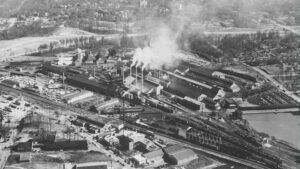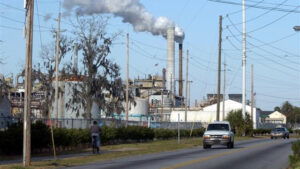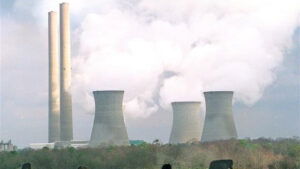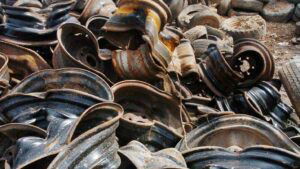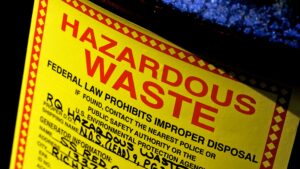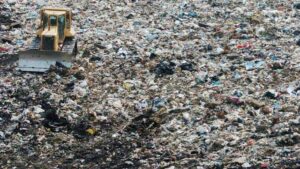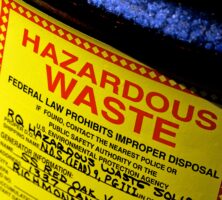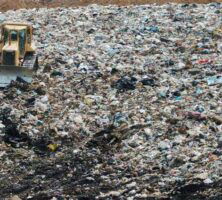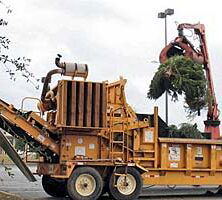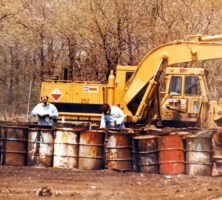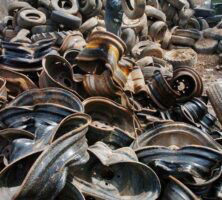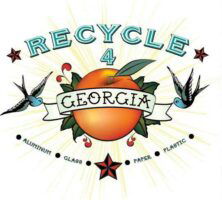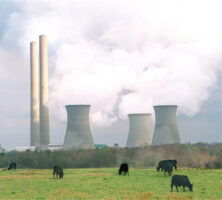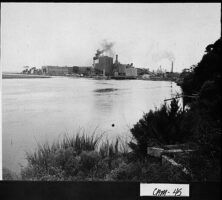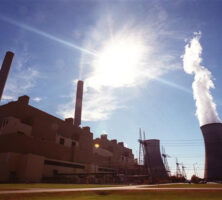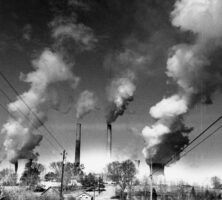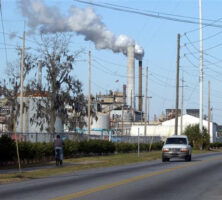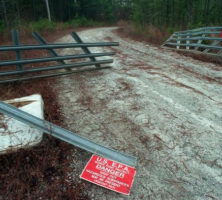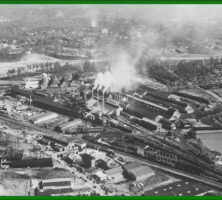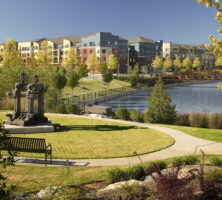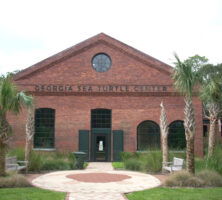The New Georgia Encyclopedia is supported by funding from A More Perfect Union, a special initiative of the National Endowment for the Humanities.
Proper procedures for handling hazardous waste include labeling and maintaining inventories of dangerous substances, as well as creating emergency-response plans in case of accidental releases.
Photograph by Jeremy Brooks
The New Georgia Encyclopedia does not hold the copyright for this media resource and can neither grant nor deny permission to republish or reproduce the image online or in print. All requests for permission to publish or reproduce the resource must be submitted to the rights holder.
Household garbage is compacted at the Seminole Road Landfill in DeKalb County, pictured in 2005. Subtitle D of the Resource Conservation and Recovery Act (RCRA) regulates the proper management of landfills in order to protect the surrounding environment and communities.
Courtesy of Atlanta Journal-Constitution, Photograph by Rich Addicks..
The New Georgia Encyclopedia does not hold the copyright for this media resource and can neither grant nor deny permission to republish or reproduce the image online or in print. All requests for permission to publish or reproduce the resource must be submitted to the Atlanta Journal-Constitution.
The New Georgia Encyclopedia does not hold the copyright for this media resource and can neither grant nor deny permission to republish or reproduce the image online or in print. All requests for permission to publish or reproduce the resource must be submitted to the rights holder.
The New Georgia Encyclopedia does not hold the copyright for this media resource and can neither grant nor deny permission to republish or reproduce the image online or in print. All requests for permission to publish or reproduce the resource must be submitted to the rights holder.
Christmas trees in Bainbridge are chipped into mulch in January 2009 as part of the statewide "Bring One for the Chipper" tree recycling program. The chipping was a joint effort by the City of Bainbridge and Keep Decatur County Beautiful.
Courtesy of Bainbridgega.com
The New Georgia Encyclopedia does not hold the copyright for this media resource and can neither grant nor deny permission to republish or reproduce the image online or in print. All requests for permission to publish or reproduce the resource must be submitted to the rights holder.
Hazardous solid waste consists of material that has been discarded and poses a threat to human health or the environment. Disposal of hazardous wastes, much of which are produced as by-products of industrial processes, is regulated by Subtitle C of the federal Resource Conservation and Recovery Act.
Courtesy of U.S. Geological Survey. Photograph by S. C. Delaney
The New Georgia Encyclopedia does not hold the copyright for this media resource and can neither grant nor deny permission to republish or reproduce the image online or in print. All requests for permission to publish or reproduce the resource must be submitted to the rights holder.
An employee at the Seminole Road Landfill in DeKalb County separates old car tires from rims in preparation for recycling. The management of solid and hazardous waste is covered by the Resource Conservation and Recovery Act (RCRA) of 1976, which was passed to help protect human and environmental health and to reduce waste.
Courtesy of Atlanta Journal-Constitution, Photograph by Rich Addicks..
The New Georgia Encyclopedia does not hold the copyright for this media resource and can neither grant nor deny permission to republish or reproduce the image online or in print. All requests for permission to publish or reproduce the resource must be submitted to the Atlanta Journal-Constitution.
Recycle 4 Georgia is a program administered by the Office of Environmental Management of the Georgia Department of Community Affairs. The program encourages local governments to manage waste through recycling by providing recycling trailers for special events.
Courtesy of Recycle 4 Georgia
The New Georgia Encyclopedia does not hold the copyright for this media resource and can neither grant nor deny permission to republish or reproduce the image online or in print. All requests for permission to publish or reproduce the resource must be submitted to the rights holder.
Major sources of industrial toxins in Georgia include agriculture, manufacturing, and coal-fired electrical power generation. Georgia Power Company's Bowen plant, a coal-fired power plant in Bartow County, is the nation's top producer of sulfur dioxide, a toxic substance.Photograph by Joe McTyre.
Courtesy of Atlanta Journal-Constitution.
The New Georgia Encyclopedia does not hold the copyright for this media resource and can neither grant nor deny permission to republish or reproduce the image online or in print. All requests for permission to publish or reproduce the resource must be submitted to the Atlanta Journal-Constitution.
The Gilman Paper Company, pictured in 1952, was located in Camden County. Like other paper mills, the Gilman Paper Company released a variety of toxins into the surrounding environment during its years of operation. The site of the plant was later cleaned under Superfund legislation.
Courtesy of Georgia Archives, Vanishing Georgia, #
cam045.
The New Georgia Encyclopedia does not hold the copyright for this media resource and can neither grant nor deny permission to republish or reproduce the image online or in print. Requests for permission to publish or reproduce the resource should be submitted to the Georgia Archives.
The New Georgia Encyclopedia does not hold the copyright for this media resource and can neither grant nor deny permission to republish or reproduce the image online or in print. All requests for permission to publish or reproduce the resource must be submitted to the rights holder.
Georgia Power Company's Scherer plant is one of twelve coal-fired power plants operating in Georgia as of 2009. These plants produce approximately 64 percent of the state's electricity with coal mined in other states.
Courtesy of Atlanta History Center, Photograph by W. A. Bridges..
The New Georgia Encyclopedia does not hold the copyright for this media resource and can neither grant nor deny permission to republish or reproduce the image online or in print. Requests for permission to publish or reproduce the resource should be submitted to the Atlanta History Center.
Georgia Power Company's Bowen coal-fired power plant, pictured in 1977, is located in Bartow County. Toxins produced by burning coal include carbon dioxide, sulfur dioxide, nitrogen oxides, and mercury compounds.Photograph by Charles Pugh.
Courtesy of Atlanta Journal-Constitution.
The New Georgia Encyclopedia does not hold the copyright for this media resource and can neither grant nor deny permission to republish or reproduce the image online or in print. All requests for permission to publish or reproduce the resource must be submitted to the Atlanta Journal-Constitution.
Hercules Inc. in Brunswick, pictured in 2004, is an active chemical processing plant. The U.S. Environmental Protection Agency identified the plant as a Superfund site because of contamination from toxic waste.
Courtesy of Atlanta Journal-Constitution.
The New Georgia Encyclopedia does not hold the copyright for this media resource and can neither grant nor deny permission to republish or reproduce the image online or in print. All requests for permission to publish or reproduce the resource must be submitted to the Atlanta Journal-Constitution.
A broken gate in Coweta County marks the entrance to a Superfund site, where 2-3 million tires were once burned. The U.S. Environmental Protection Agency oversees the cleanup of toxic-waste sites under the federal Comprehensive Environmental Response, Compensation, and Liability Act (CERCLA, or Superfund).
Courtesy of Atlanta Journal-Constitution.
The New Georgia Encyclopedia does not hold the copyright for this media resource and can neither grant nor deny permission to republish or reproduce the image online or in print. All requests for permission to publish or reproduce the resource must be submitted to the Atlanta Journal-Constitution.
The New Georgia Encyclopedia does not hold the copyright for this media resource and can neither grant nor deny permission to republish or reproduce the image online or in print. All requests for permission to publish or reproduce the resource must be submitted to the rights holder.
The Atlantic Steel Mill in Atlanta operated for more than 100 years before closing in 1998. The contamined 138-acre site on which the mill stood was cleaned as part of the largest brownfield reclamation project in the nation. In 2001 it reopened as Atlantic Station, a mixed-use development complex.
Courtesy of U.S. Environmental Protection Agency
The New Georgia Encyclopedia does not hold the copyright for this media resource and can neither grant nor deny permission to republish or reproduce the image online or in print. All requests for permission to publish or reproduce the resource must be submitted to the rights holder.
The New Georgia Encyclopedia does not hold the copyright for this media resource and can neither grant nor deny permission to republish or reproduce the image online or in print. All requests for permission to publish or reproduce the resource must be submitted to the rights holder.
Atlantic Station, a development on the west side of Atlanta, was built on a reclaimed brownfield and designed according to the principles of New Urbanism, an architectural movement that offers an alternative to the suburban, automobile-dependent lifestyle.
Courtesy of Atlantic Station
The New Georgia Encyclopedia does not hold the copyright for this media resource and can neither grant nor deny permission to republish or reproduce the image online or in print. All requests for permission to publish or reproduce the resource must be submitted to the rights holder.
The Georgia Sea Turtle Center on Jekyll Island opened in 2007 to provide veterinary care to injured sea turtles and to educate the public about sea turtle conservation. The facility was built on a reclaimed brownfield, the former site of a coal-fired power plant that had contaminated the property with various industrial toxins.
Courtesy of Georgia Sea Turtle Center
The New Georgia Encyclopedia does not hold the copyright for this media resource and can neither grant nor deny permission to republish or reproduce the image online or in print. All requests for permission to publish or reproduce the resource must be submitted to the rights holder.
